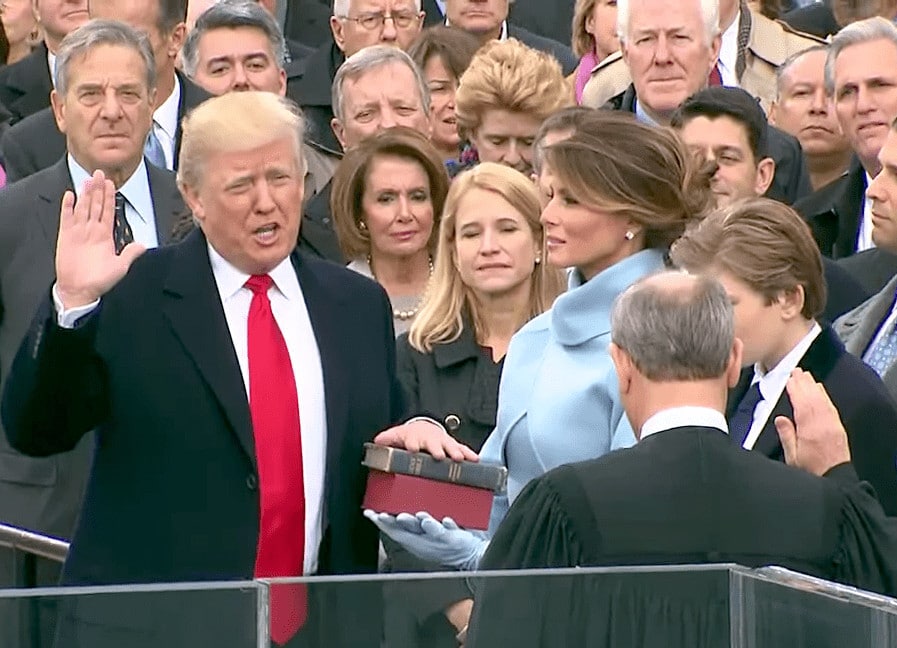Trump rightfully takes ‘preserve, protect, and defend’ to heart
Originally published by Newsmax
Democratic Vice Presidential candidate Kamala Harris very recently accused President Donald Trump of violating his oath of office, “He failed to protect the American people,” said Harris, calling that failure, “reckless disregard for the health of the American people. . . . He never realized that as President he swore a sacred oath, before God, to protect America against threats, seen and unseen,” referring to the COVID-19 pandemic.
President Trump said this in his nomination acceptance speech at the Republican National Convention, “If the left gains power, they will demolish the suburbs, confiscate your guns, and appoint justices who will wipe away your Second Amendment and other Constitutional freedoms.”
Kamala Harris is wrong about the presidential oath. Her accusations raise two related questions: (1) What threats to the American people is the president oath-bound to protect us against?; and (2) What powers does the president have “to protect the American people” against COVID-19?
The first question is easier than the second. Article II, Section I, of the Constitution prescribes this oath of office for the president: “Before he enter on the Execution of the Office, he shall take the following oath or affirmation: — ‘I do solemnly swear (or affirm) that I will faithfully execute the Office of President of the United States, and will to the best of my Ability, preserve, protect and defend the Constitution of the United States’.”
The answer to the first question is thus in the Constitution itself: the president is only oath-bound to “preserve, protect and defend the Constitution of the United States.”
The starting point for answering this second question is two-fold: (a) the original purpose of the Constitution, which was to establish a framework for our national government of limited powers; and (b) the final provision of the Bill of Rights, aka the 10th Amendment: “The powers not delegated to the United States by the Constitution, nor prohibited by it to the States, are reserved to the States respectively, or to the People.”
In 1992 the U.S. Supreme Court reaffirmed the foundational principle of limited national government and in the same case, New York v. United States, 505 U.S. 144 (1992), explained how we should — and should not — address questions of the extent of national powers: “While no one disputes the proposition that ‘[t]he Constitution created a Federal Government of limited powers,’ . . . [o]ur task . . . consists not of devising our preferred system of government, but of understanding and applying the framework set forth in the Constitution. ‘The question is not what power the Federal Government ought to have but what powers in fact have been given by the people’.” (internal citations omitted)
Through this constitutional prism, the question comes down to this: What “powers in fact have been given by the people” for the president, to quote Kamela Harris, “to protect America against threats, seen and unseen,” in the health context?
Article I of the Constitution begins: “All legislative Powers herein, granted shall be vested in a Congress of the United States, which shall consist of a Senate and House of representatives.” Article II begins: “The executive power shall be vested in a President of the United States of America.” Article II also provides that, “The President shall be Commander in Chief of the Army and Navy of the United States, and of the Militia of the several States, when called into actual Service of the United States.”
These enumerated powers of the President beg the Supreme Court’s question about the limits of national power: “What powers in fact have been given by the people” to their President to protect Americans from the COVID-19 pandemic?
The most obvious power “given by the people” is the inherent power of national leadership, especially as commander in chief and in foreign affairs. Aside from curtailing travel from China, a fact sheet posted on the White House website explains how President Trump “is harnessing the full power of the public and private sectors to deliver a safe and effective vaccine as soon as possible.”
When he accepted the Republican nomination Thursday night, President Trump explained:
“When the China Virus hit, we launched the largest national mobilization since World War II. Invoking the Defense Production Act, we produced the world’s largest supply of ventilators.
“Not a single American who has needed a ventilator has been denied a ventilator. We shipped hundreds of millions of masks, gloves and gowns to our front line healthcare workers.
“To protect our nation’s seniors, we rushed supplies, testing kits, and personnel to nursing homes and long term care facilities. The Army Corps of Engineers built field hospitals, and the Navy deployed our great hospital ships.”
Thank God President Trump takes his oath seriously to “preserve, protect and defend the Constitution of the United States,” and continues to exercise leadership — within the constraints of that Constitution — to protect us from COVID-19.
- ‘America’s Enduring Prayer’ — 19 Years Ago - September 14, 2020
- Trump rightfully takes ‘preserve, protect, and defend’ to heart - August 31, 2020
- 1775 declaration foreshadowed current need for unity - July 8, 2020

